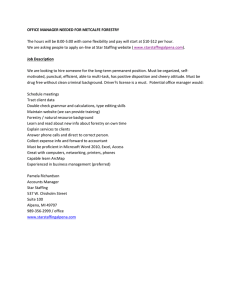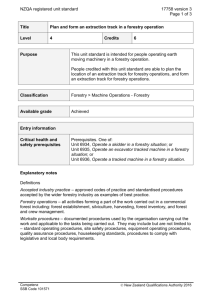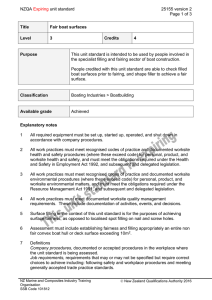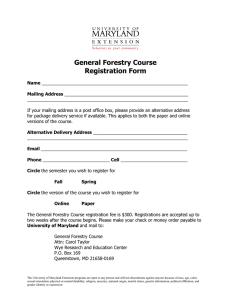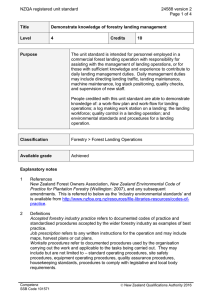Document 15208814
advertisement
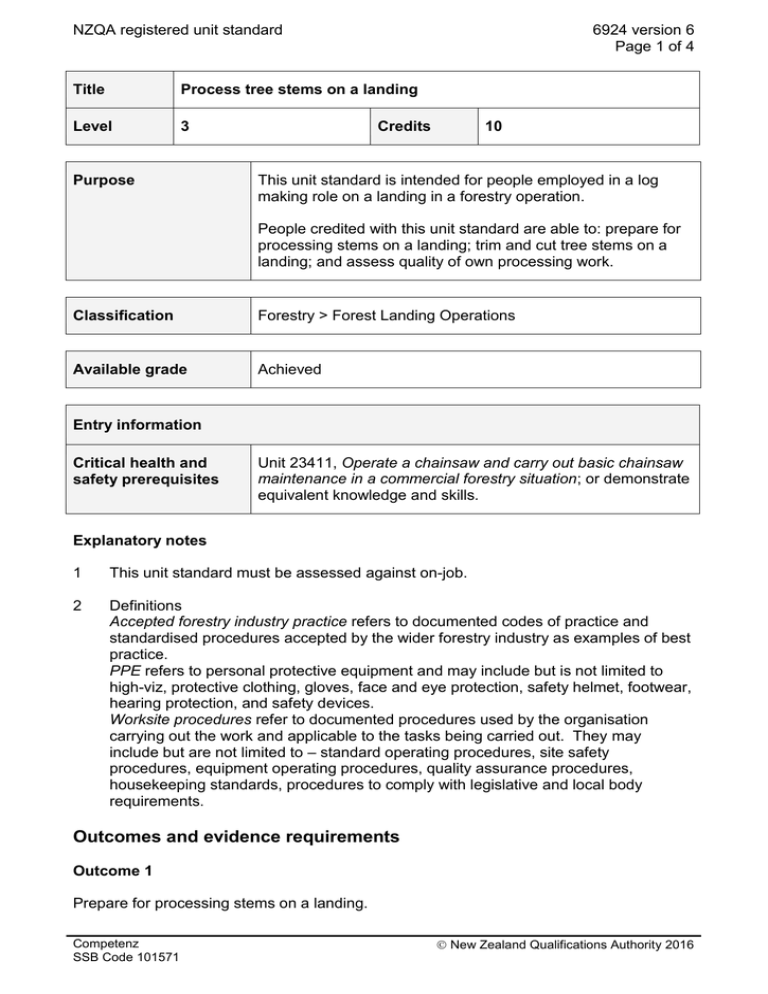
NZQA registered unit standard 6924 version 6 Page 1 of 4 Title Process tree stems on a landing Level 3 Purpose Credits 10 This unit standard is intended for people employed in a log making role on a landing in a forestry operation. People credited with this unit standard are able to: prepare for processing stems on a landing; trim and cut tree stems on a landing; and assess quality of own processing work. Classification Forestry > Forest Landing Operations Available grade Achieved Entry information Critical health and safety prerequisites Unit 23411, Operate a chainsaw and carry out basic chainsaw maintenance in a commercial forestry situation; or demonstrate equivalent knowledge and skills. Explanatory notes 1 This unit standard must be assessed against on-job. 2 Definitions Accepted forestry industry practice refers to documented codes of practice and standardised procedures accepted by the wider forestry industry as examples of best practice. PPE refers to personal protective equipment and may include but is not limited to high-viz, protective clothing, gloves, face and eye protection, safety helmet, footwear, hearing protection, and safety devices. Worksite procedures refer to documented procedures used by the organisation carrying out the work and applicable to the tasks being carried out. They may include but are not limited to – standard operating procedures, site safety procedures, equipment operating procedures, quality assurance procedures, housekeeping standards, procedures to comply with legislative and local body requirements. Outcomes and evidence requirements Outcome 1 Prepare for processing stems on a landing. Competenz SSB Code 101571 New Zealand Qualifications Authority 2016 NZQA registered unit standard 6924 version 6 Page 2 of 4 Evidence requirements 1.1 PPE and equipment suitable for processing stems is maintained in a safe and serviceable condition in accordance with accepted forestry industry practice. Range chainsaw, wedges, protective clothing, fuel and oil containers, first aid equipment, high visibility clothing. 1.2 Hazards on a log landing are identified and managed in accordance with accepted forestry industry practice and worksite procedures. 1.3 The reason for on-going hazard identification is explained in accordance with accepted forestry industry practice. 1.4 Factors that may change hazards or introduce new hazards are described in accordance with accepted forestry industry practice. Range 1.5 weather, change of layout, change of location. The terms tension and compression are defined in accordance with accepted forestry industry practice. Outcome 2 Trim and cut tree stems on a landing. Evidence requirements 2.1 Communication requirements for processing stems on a landing are maintained with other workers and machine operators in accordance with worksite procedures. Range 2.2 may include – audio, visual, hand signals; evidence of two communication requirements is required. Chainsaw use meets the requirements of accepted forestry industry practice. Range cutting technique, body position, clear of workers, stance, safe areas. 2.3 Tension and compression are identified and managed as cuts are made in accordance with accepted forestry industry practice. 2.4 Branches and branch stubs are removed in accordance with accepted forestry industry practice. Range 2.5 flush with the log, minimal stem damage. Stems are cut to meet operational requirements in accordance with worksite procedures. Competenz SSB Code 101571 New Zealand Qualifications Authority 2016 NZQA registered unit standard Range 6924 version 6 Page 3 of 4 straight cuts, combination cuts, slovens and shattered ends are cut where marked. 2.6 Logs are processed at a rate which meets operational requirements and complements that of other workers. 2.7 Logs are presented in a prepared state prior to stockpiling and loading in accordance with worksite procedures. Outcome 3 Assess quality of own processing work. Evidence requirements 3.1 The benefits of performing quality control on a log making operation are described in accordance with accepted forestry industry practice. 3.2 The quality of their own cross cutting and trimming is checked against specifications in accordance with worksite procedures. Range 3.3 evidence of a minimum of five stems is required. Errors identified during self-assessment are remedied where possible, and methods to minimise errors in the future are explained in accordance with accepted forestry industry practice. Planned review date 31 December 2020 Status information and last date for assessment for superseded versions Process Version Date Last Date for Assessment Registration 1 8 November 1996 31 December 2012 Revision 2 19 June 1998 31 December 2012 Review 3 5 December 2000 31 December 2012 Review 4 22 May 2008 31 December 2013 Revision 5 15 September 2011 31 December 2016 Review 6 19 March 2015 N/A Consent and Moderation Requirements (CMR) reference 0173 This CMR can be accessed at http://www.nzqa.govt.nz/framework/search/index.do. Please note Providers must be granted consent to assess against standards (accredited) by NZQA, before they can report credits from assessment against unit standards or deliver courses of study leading to that assessment. Competenz SSB Code 101571 New Zealand Qualifications Authority 2016 NZQA registered unit standard 6924 version 6 Page 4 of 4 Industry Training Organisations must be granted consent to assess against standards by NZQA before they can register credits from assessment against unit standards. Providers and Industry Training Organisations, which have been granted consent and which are assessing against unit standards must engage with the moderation system that applies to those standards. Requirements for consent to assess and an outline of the moderation system that applies to this standard are outlined in the Consent and Moderation Requirements (CMR). The CMR also includes useful information about special requirements for organisations wishing to develop education and training programmes, such as minimum qualifications for tutors and assessors, and special resource requirements. Comments on this unit standard Please contact Competenz qualifications@competenz.org.nz if you wish to suggest changes to the content of this unit standard. Competenz SSB Code 101571 New Zealand Qualifications Authority 2016
